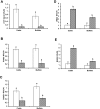The gene expression pattern induced by high plating density in cultured bovine and buffalo granulosa cells might be regulated by specific miRNA species
- PMID: 25740097
- PMCID: PMC4410314
- DOI: 10.1262/jrd.2014-119
The gene expression pattern induced by high plating density in cultured bovine and buffalo granulosa cells might be regulated by specific miRNA species
Abstract
Precise regulation of cell type-specific gene expression profiles precedes the profound morphological reorganization of somatic cell layers during folliculogenesis, ovulation and luteinization. Cell culture models are essential to the study of corresponding molecular mechanisms of gene regulation. In a recent study, it was shown that an increased cell plating density can largely change gene expression profiles of cultured bovine granulosa cells. In our present study, we comparatively analyzed cell plating density effects on cultured bovine and buffalo granulosa cells. Cells were isolated from small- to medium-sized follicles (2-6 mm) and cultured under serum-free conditions at different plating densities. The abundance of selected marker transcripts and associated miRNA candidates was determined by quantitative real-time RT-PCR. We found in both species that the abundance of CYP19A1, CCNE1 and PCNA transcripts was remarkably lower at a high plating density, whereas VNN2 and RGS2 transcripts significantly increased. In contrast, putative regulators of CYP19A1, miR-378, miR-106a and let-7f were significantly higher in both species or only in buffalo, respectively. Also miR-15a, a regulator of CCNE1, was upregulated in both species. Thus, increased plating density induced similar changes of mRNA and miRNA expression in granulosa cells from buffalo and cattle. From these data, we conclude that specific miRNA species might be involved in the observed density-induced gene regulation.
Figures



Similar articles
-
Increasing cell plating density mimics an early post-LH stage in cultured bovine granulosa cells.Cell Tissue Res. 2013 Dec;354(3):869-80. doi: 10.1007/s00441-013-1712-9. Epub 2013 Sep 13. Cell Tissue Res. 2013. PMID: 24026437
-
Suitable housekeeping genes for normalization of transcript abundance analysis by real-time RT-PCR in cultured bovine granulosa cells during hypoxia and differential cell plating density.Reprod Biol Endocrinol. 2014 Nov 27;12:118. doi: 10.1186/1477-7827-12-118. Reprod Biol Endocrinol. 2014. PMID: 25430436 Free PMC article.
-
Induction of altered gene expression profiles in cultured bovine granulosa cells at high cell density.Reprod Biol Endocrinol. 2017 Jan 5;15(1):3. doi: 10.1186/s12958-016-0221-6. Reprod Biol Endocrinol. 2017. PMID: 28056989 Free PMC article.
-
Cell plating density alters the ratio of estrogenic to progestagenic enzyme gene expression in cultured granulosa cells.Fertil Steril. 2010 Apr;93(6):2050-5. doi: 10.1016/j.fertnstert.2009.01.151. Epub 2009 Mar 26. Fertil Steril. 2010. PMID: 19324349
-
Expression and localization of fibroblast growth factor (FGF) family in buffalo ovarian follicle during different stages of development and modulatory role of FGF2 on steroidogenesis and survival of cultured buffalo granulosa cells.Res Vet Sci. 2016 Oct;108:98-111. doi: 10.1016/j.rvsc.2016.08.012. Epub 2016 Aug 31. Res Vet Sci. 2016. PMID: 27663377
Cited by
-
"Positive Regulation of RNA Metabolic Process" Ontology Group Highly Regulated in Porcine Oocytes Matured In Vitro: A Microarray Approach.Biomed Res Int. 2018 Jan 10;2018:2863068. doi: 10.1155/2018/2863068. eCollection 2018. Biomed Res Int. 2018. PMID: 29546053 Free PMC article.
-
Variations of follicular fluid extracellular vesicles miRNAs content in relation to development stage and season in buffalo.Sci Rep. 2022 Sep 1;12(1):14886. doi: 10.1038/s41598-022-18438-8. Sci Rep. 2022. PMID: 36050481 Free PMC article.
References
-
- Mihm M, Bleach EC. Endocrine regulation of ovarian antral follicle development in cattle. Anim Reprod Sci 2003; 78: 217–237. - PubMed
-
- Murphy BD. Luteinization. 2nd ed., Leung PC and Adashi EY (eds.), Burlington MA, Academic Press; 2004:185-199.
-
- Milvae RA, Hinckley ST, Carlson JC. Luteotropic and luteolytic mechanisms in the bovine corpus luteum. Theriogenology 1996; 45: 1327–1349. - PubMed
-
- Smith MF, McIntush EW, Smith GW. Mechanisms associated with corpus luteum development. J Anim Sci 1994; 72: 1857–1872. - PubMed
Publication types
MeSH terms
Substances
LinkOut - more resources
Full Text Sources
Other Literature Sources
Miscellaneous

